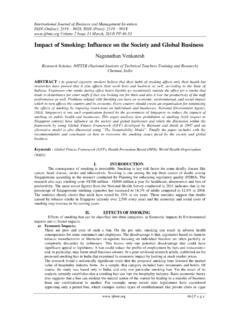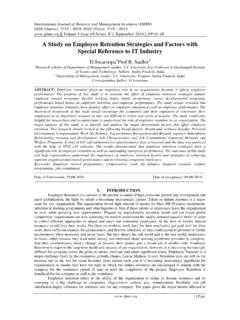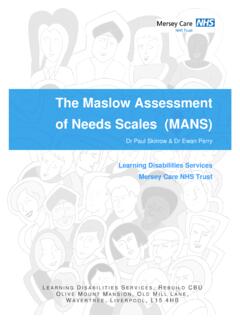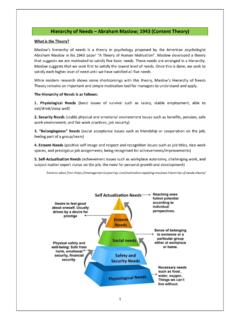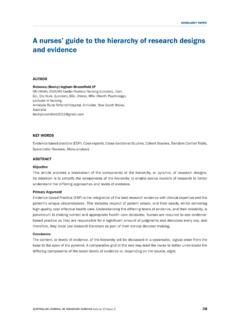Transcription of Application of the Maslow’s hierarchy of need theory ...
1 International Journal of Business and Management Invention ISSN (Online): 2319 8028, ISSN (Print): 2319 801X Volume 2 Issue 3 March. 2013 39 | P a g e Application of the Maslow s hierarchy of need theory ; impacts and implications on organizational culture, human resource and employee s performance Dr. Nyameh Jerome Department of Economics Taraba State University Jaling,. Nigeria. ABSTRACT:Coherent group of tested general propositions, commonly regarded as correct, that can be used as principles of explanation and prediction for a class of phenomena is refers to theory , it is extremely difficult to empirically test Maslow's hierarchy needs in a way that causal relationships can be established Several studies and books have argued that Personal opinion is always prone to bias, which reduces the validity of any data obtained.
2 Therefore Maslow's operational definition of hierarchy of needs must not be blindly accepted as scientific fact because is mostly irrelevant in certain organizations and part of the world, may be simply because of the difficulties in the Application of the theory . Contrary to the above assertion, the review suggests and recommends the relevancy of the hierarchy of needs theory in business organizations today, the review explores the relevance of the theory on organizational culture, human resource management and employee s performance and its Application towards achieving results in the attainment of organizational goals and objectives.
3 Keywords: hierarchy of needs theory , organizational culture, HRM and Employee s performance I. INTRODUCTION Maslow's hierarchy of needs is a theory in psychology anticipated by Abraham Maslow in his 1943 paper "A theory of Human Motivation". Maslow consequently extended the idea to include his observations of humans' innate curiosity, over the years researches and authors has tend to criticizes the theory as being irrelevant in most part of the world for is western in nature Contrary to such assertion, Maslow s hierarchy of needs theory remains relevant in every sector of our business today as its best analyzes below Maslow s hierarchy of needs where the lower order needs (physiological and safety needs )
4 May be linked to organizational culture. Every new organization passes through this lower order stage in which they struggle with their basic survival needs . At the third level of the Maslow s hierarchy , social needs would correspond to the formation of organized roles within the organization into distinct units, depicting the human resource management function which resonates according to the tone set by organizational culture. The positive interaction of organizational culture and human resource management would result in self-esteem and self-actualization.
5 This is manifested through the employees performance which showcases the strength and reliability of their organization in the face of competitors. It also implies that the organization through its employees has excelled and met their objectives, mission and vision statement, a stage that can be considered parallel to self-actualization. ORGANIZATIONAL CULTURE Organizational culture has proven to be very elusive because of the lack of a single definition that is generally accepted by all organizational culture literatures.
6 One of the issues involving culture is that it is defined both in terms of its causes and effects (Shili, 2008). Organizational culture is a complex network of values and norms that guides an individual s behaviors. It involves a set of beliefs, values, assumptions and experience that are acquired through learning, socializing and sharing by members of social unit such as people in the organization (Rousseau, 1990) Almost all the definitions of culture emphasizes the organizational assumptions developed, nurtured and mentored consciously or unconsciously over organization s life cycle;, these includes experiences, norms, values, philosophy and rituals that hold the organization together.
7 Its portrait, self-image, inner workings, interaction with the outside environment where some of the values are kept in written form while others are unwritten but yet adhered to strictly (Schein, 1984). The culture of an organization is sometimes dynamic in nature, particularly after doing effective strength and weakness analysis, out of which can be eliminated and advantages retained and strengthened (Shumen, 2009). A valid organizational culture is called corporate culture (Shumen, 2009).
8 Schein (1984) Application OF THE MASLOW S hierarchy OF NEED theory ; IMPACTS AND 40 | P a g e argues that we can describe "how" a group constructs its environment and which behavior patterns are discernible among the way it does its things. It is clear that organizational culture is a process that the organizational founders, top management and employees learn, socialize and adopt over time (Schein, 1984). It selects the best culture that suits the organization s objectives and that can be easily be accepted by wider environment (Robbins & Judge, 2009).
9 Organizational culture is the normative glue that holds an organization together (Tichy, Fombrun & Devanna, 1982). Support by Schein (1990), in a more comprehensive fashion, argued that culture, as values and behaviors that are believed to lead to success and are thus taught to new members. Forehand and Gilmer (1964) suggest that culture is the set of characteristics that describe an organization and distinguish it from others. Alvesson and Berg (1992) state that, organizational culture is a management tool that helps in work rationalization and efficiency thinking: an attempt to develop control mechanisms that are not based on compulsion or on direction.
10 Parker (2000) argues that workers strive to get to command themselves or each other. The manager s task is considered to be the creation of a culture and its manipulation. The power of cultural theories is seen particularly in fields in which direct control and guidance mechanisms are difficult or impossible to maintain (Parker, 2000). Collins (1998) sums up the matter by stating that cultures are historically developed, socially maintained and individually interpreted. Every culture, however, has an in-built propensity to merge behavior, which happens by creating common norms and a shared social identity; such absolute behavior within a given organization is called corporate culture (Collins, 1998).








